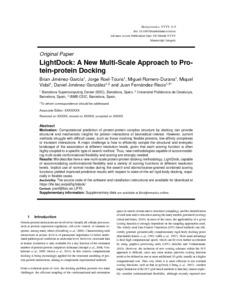LightDock: a new multi-scale approach to protein–protein docking

10.1093/bioinformatics/btx555
Inclou dades d'ús des de 2022
Cita com:
hdl:2117/114893
Tipus de documentArticle
Data publicació2017-09-04
EditorOxford University Press
Condicions d'accésAccés obert
Tots els drets reservats. Aquesta obra està protegida pels drets de propietat intel·lectual i
industrial corresponents. Sense perjudici de les exempcions legals existents, queda prohibida la seva
reproducció, distribució, comunicació pública o transformació sense l'autorització del titular dels drets
ProjecteDESARROLLO DE NUEVAS METODOLOGIAS DE DOCKING ENTRE PROTEINAS PARA LOS RETOS DE INTERACTOMICA Y MEDICINA PERSONALIZADA (MINECO-BIO2013-48213-R)
HiPEAC - High Performance and Embedded Architecture and Compilation (EC-H2020-687698)
COMPUTACION DE ALTAS PRESTACIONES VII (MINECO-TIN2015-65316-P)
HiPEAC - High Performance and Embedded Architecture and Compilation (EC-H2020-687698)
COMPUTACION DE ALTAS PRESTACIONES VII (MINECO-TIN2015-65316-P)
Abstract
Computational prediction of protein–protein complex structure by docking can provide structural and mechanistic insights for protein interactions of biomedical interest. However, current methods struggle with difficult cases, such as those involving flexible proteins, low-affinity complexes or transient interactions. A major challenge is how to efficiently sample the structural and energetic landscape of the association at different resolution levels, given that each scoring function is often highly coupled to a specific type of search method. Thus, new methodologies capable of accommodating multi-scale conformational flexibility and scoring are strongly needed.
We describe here a new multi-scale protein–protein docking methodology, LightDock, capable of accommodating conformational flexibility and a variety of scoring functions at different resolution levels. Implicit use of normal modes during the search and atomic/coarse-grained combined scoring functions yielded improved predictive results with respect to state-of-the-art rigid-body docking, especially in flexible cases.
CitacióJiménez-García, B. [et al.]. LightDock: a new multi-scale approach to protein–protein docking. "Bioinformatics", 4 Setembre 2017, vol. 34, núm. 1, p. 49-55.
ISSN1367-4803
Col·leccions
| Fitxers | Descripció | Mida | Format | Visualitza |
|---|---|---|---|---|
| LightDock A New ... rotein-protein Docking.pdf | 473,8Kb | Visualitza/Obre |

